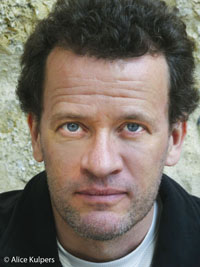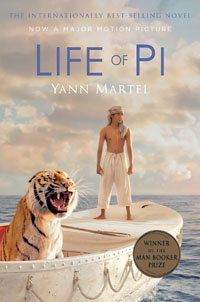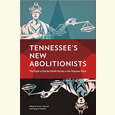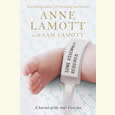Life After Pi
Yann Martel talks with Chapter 16 about this year’s Nashville Reads pick
Yann Martel’s novel, Life of Pi, weaves philosophy, magic realism, meta-narrative, and good old fashioned suspense into a ripping yarn—and when it was published in 2001, the critics, and readers, went wild. The book became a blockbuster in every sense of the word: it spent fifty-seven weeks on The New York Times bestseller list, won the 2002 Man Booker Prize as well as a host of other international literary prizes, was translated into forty languages, and has, to date, sold more than seven million copies. A deftly imagined fable-cum-literary-quandary, the novel tells the story of a young Indian boy named Piscine Molitor who survives 227 days adrift on a lifeboat with an adult male Bengal tiger. Overnight, Life of Pi made Martel, a hitherto unknown Canadian writer, a literary sensation.
In 2007, firmly established as one of his country’s foremost literary luminaries, Martel found himself in the Visitor’s Gallery of Canada’s House of Commons to celebrate fifty years of Canadian funding for the arts. After a perfunctory greeting from the Minister for Canadian Heritage, the event was over. Martel was stunned. “Fifty years of building Canada’s dazzling and varied culture, done with in less than five minutes?” he wrote afterward. “Do we count for nothing, you philistines, I felt like shouting down at the House. Don’t you know that Canadians love their books and songs and paintings?” But instead of making a scene, Martel decided to act. “For as long as Stephen Harper is Prime Minister of Canada, I vow to send him every two weeks, mailed on a Monday, a book that has been known to expand stillness. That book will be inscribed and will be accompanied by a letter I will have written.” He began with Tolstoy’s Death of Ivan Ilyitch. Harper did not respond.
Nor did Harper respond to subsequent literary gifts. Though Martel clearly knew, after a point, that he was writing into a void, the letters are charming. (The full text of each, along with his literary suggestions, can be found here.) After a hundred books and zero responses, he ended the project in February of this year, with Proust’s In Search of Lost Time as the final recommendation.
 Martel’s follow-up to Life of Pi, a Beckettian fable called Beatrice and Virgil was published in 2010, and the same critics who had loved Life of Pi turned savage. Michiko Kakutani of The New York Times called it “every bit as misconceived and offensive as his earlier book was fetching.” Ron Charles, writing in The Washington Post, pronounced it “so dull, so misguided, so pretentious that only the prospect of those millions of ‘Pi’ fans could secure the interest of major publishers.” And yet Booklist gave Beatrice and Virgil a starred review, and USA Today called it a “dark but divine” masterpiece. Whatever the assessment of the book’s merits, no one can accuse Martel of resting on his laurels: an allusion-laden Holocaust narrative whose cast of characters features a taxidermist, a famous novelist, and a talking monkey who attempt to find their way across a gigantic striped shirt, Beatrice and Virgil is in fact about as unlike Life of Pi as it is possible for a book to be. Chapter 16 caught up with the author via email:
Martel’s follow-up to Life of Pi, a Beckettian fable called Beatrice and Virgil was published in 2010, and the same critics who had loved Life of Pi turned savage. Michiko Kakutani of The New York Times called it “every bit as misconceived and offensive as his earlier book was fetching.” Ron Charles, writing in The Washington Post, pronounced it “so dull, so misguided, so pretentious that only the prospect of those millions of ‘Pi’ fans could secure the interest of major publishers.” And yet Booklist gave Beatrice and Virgil a starred review, and USA Today called it a “dark but divine” masterpiece. Whatever the assessment of the book’s merits, no one can accuse Martel of resting on his laurels: an allusion-laden Holocaust narrative whose cast of characters features a taxidermist, a famous novelist, and a talking monkey who attempt to find their way across a gigantic striped shirt, Beatrice and Virgil is in fact about as unlike Life of Pi as it is possible for a book to be. Chapter 16 caught up with the author via email:
Chapter 16: After two years on the “What is Stephen Harper Reading?” project, you really heard nothing at all from the P.M.?
Yann Martel: That’s right. I sent the Prime Minister of Canada one hundred books and one hundred letters, and for all my efforts I got zero, zilch, nada, not a squeak from him in return. And yet I live in a democracy. My leaders are supposed to be accountable to me. The financial assets of politicians are supposed to be an open book, so that we know that they are not acting in self-interest against the public interest. Why shouldn’t their imaginative assets also be an open book? Don’t we want to know where our politicians get their dreams for us? After all, that is one of the roles of a leader, to say to us, “I have a dream, this is where I want to lead you.” And I don’t know how anyone can have great dreams for others if they don’t read literature. There’s no better tool to explore the human condition—life, people, the world—than the great novel. To have a leader who has never thought of life through the prism of literature scares me because that means they have only lived, and therefore only know, their single, narrow life.
Chapter 16: And yet you did receive a handwritten letter from Barack Obama, telling you how much he enjoyed Life of Pi. If President Obama were to ask you for a reading list, what books would you urge on him?
Yann Martel: I know what to suggest to someone who doesn’t read, having done so for close to four years. But President Obama reads, has in the past and continues to do so now, busy though he is, so I become more humble since President Obama and I are, in this case, equal readers. But considering what is happening in the Middle East right now, perhaps a novel or two by Naguib Mahfouz, the great Egyptian writer, would be a good idea.
Chapter 16: At the beginning of Beatrice and Virgil, we meet the author Henry, who is trying to publish an unorthodox book about the Holocaust after publishing a critically lauded bestseller. One imagines you might have some experience with this particular situation. Did you also feel hemmed in by critical and commercial expectations after Life of Pi?
 Yann Martel: Not at all. Each book I’ve written has been an entirely new creative experience. I enjoyed the great and unexpected success of Life of Pi. What writer wouldn’t? To see my book connect with so many readers was a joy and a privilege. But then I moved on. I had another novel to write and sat down to write it, forgetting about Life of Pi. I had expectations about B&V, but these were entirely my own, different from the expectation of publishers, critics, and readers. You have to let go, that’s one of the great lessons of life. I’m about to start work on my next novel, so I’m now in the process of letting go of B&V.
Yann Martel: Not at all. Each book I’ve written has been an entirely new creative experience. I enjoyed the great and unexpected success of Life of Pi. What writer wouldn’t? To see my book connect with so many readers was a joy and a privilege. But then I moved on. I had another novel to write and sat down to write it, forgetting about Life of Pi. I had expectations about B&V, but these were entirely my own, different from the expectation of publishers, critics, and readers. You have to let go, that’s one of the great lessons of life. I’m about to start work on my next novel, so I’m now in the process of letting go of B&V.
Chapter 16: Every artist must find a way to cope with critical opinion, but you have encountered an unusually huge range of reactions—reviews which are absolutely transcendent, as well as reviews that are scathing. How do you account for the extremes of opinion that your work seems to inspire?
Yann Martel: I mostly ignore critical opinion, good and bad. Art is a gift, the making of it, the receiving of it. So, like every artist, I create and then I give. What the world does with my gift—raise it up high or cast it down—is not my affair. For example, Beatrice and Virgil received an awful review from The New York Times’ Michiko Kakutani. She positively hated the novel, as did the reviewers for The Washington Post and the San Francisco Chronicle. What can you do? That was their reaction to my take on the Holocaust. That’s their affair. They didn’t want to go where I went.
Chapter 16: In an interview on the Beatrice and Virgil website, you say you hope that the novel will expand the range of possible responses to the Holocaust. “I see Beatrice and Virgil as a mnemonic novel,” you write, “a novel that helps remember, but remember in a new way, so that a reader who’s read it will now think of the Holocaust when he or she sees a donkey, say, or eats a pear, or puts on a shirt, or sees a red cloth, and so on.” Can you elaborate on the idea of a mnemonic novel, or any art that functions as mnemonic?
Yann Martel: Art does many things. In this case, I wanted to represent the Holocaust in a different way. We know a lot about the Holocaust. It is one of the most thoroughly investigated events in history. But not as much thought and research has gone into how it is represented, in other words, how we bridge the event then and where we are now. We don’t live between 1933 and 1945 anymore. We can’t capture that reality with the vividness of the present moment. So we need to make the Holocaust live in terms that are meaningful today. That means allowing the imagination in to pick and choose how to represent the Holocaust. This does not mean denaturing the Holocaust. To think so is to misunderstand the nature of art. Art gets to the essential core of an event without worrying about the external facts. Art is a shorthand, a very powerful shorthand. So it’s perfect to take on an historical event, one that is receding into the past. If a work of art successfully represents a past event, I’d call it mnemonic, in other words, it helps remember. With that artistic representation as a first remembrance, a reader can then go further, if he or she wishes, and read more, whether in a fictional or historical mode.
Chapter 16: Life of Pi has entered the canon; it was the first book assigned to my son when he started high school last fall. I asked his English teacher how she taught the book—what she encouraged her students to look closely at and take away from it—and she said it’s “a great way to introduce the great existential dilemmas to students.” She and her colleagues link Life of Pi in the curriculum to the Book of Job. What do you make of that connection?
Yann Martel: Why not? We have a mind that has an unparalleled capacity to reason, and it wants answers and reasons for everything, yet Fate is inexplicable. This is a conundrum that defines the human condition. The Book of Job is about that, and Life of Pi can perhaps be read in that light, too, although in my thinking, Pi is more empowered than Job. I’d also argue that God is more on Pi’s side than He seemed to be on Job’s.
Chapter 16: Finally, this last question, also about Life of Pi, comes directly from my son: “Which story did you like better? The story about the animals, or the other one?”
Yann Martel:That’s for each reader to answer. Any work of art is a co-creation between the artist and the reader/viewer/spectator. My interpretation of Pi is just one reading among many possible readings, and it should not have any more weight because I’m its author. Having said that, I don’t see the point in making less of life. It’s short enough as it is, so why not see more in it? Why not make leaps of faith? We’re not computers, after all. There’s no point in being entirely reasonable one’s whole life. Reason is merely a tool at the service of faith, whether that faith is in a religion, a loved one, a political party or doctrine, or a sports team. Faith is the motor of life. A life without any faith in anything is a sad waste of time. There, that should give you an idea of which story I prefer.
[This interview, with a slightly different introduction, appeared originally on March 7, 2011.]
February 26 update: Yann Martel will give a lecture at the Nashville Public Library on March 2 at 3 p.m. as the kickoff event for Nashville Reads, a partnership between the library, the office of Mayor Karl Dean, Humanities Tennessee, Parnassus Books, Friends of the Library, Houghton Mifflin Harcourt, and the Nashville Public Library Foundation. Martel’s reading is the first event in a series of activities, including a screening of the film Life of Pi, in a citywide reading campaign that extends through April 13. The event is free and open to the public, but tickets are available in advance by clicking here.





